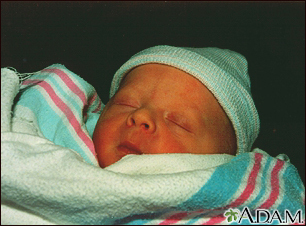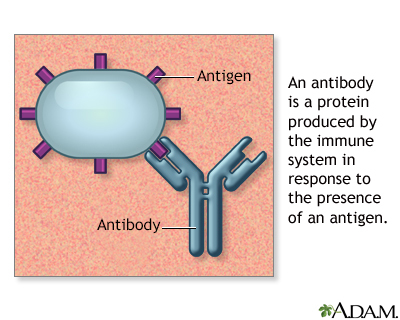ABO incompatibility
Definition
A, B, AB, and O are the 4 major blood types. The types are based on small substances (molecules) on the surface of the blood cells.
When people who have one blood type receive blood from someone with a different blood type, it may cause their immune system to react. This is called ABO incompatibility.
Due to modern testing techniques, this problem is very rare.
Alternative Names
Transfusion reaction - hemolytic; Acute hemolytic transfusion reaction; AHTR; Blood incompatibility - ABO
Causes
The different blood types are:
- Type A
- Type B
- Type AB
- Type O
People who have one blood type may form proteins (antibodies) that cause their immune system to react against one or more of the other blood types.
Being exposed to another type of blood can cause a reaction. This is important when someone needs to receive a blood transfusion or have an organ transplant. The blood types must be compatible to avoid an ABO incompatibility reaction.
For example:
- People with type A blood will react against type B or type AB blood.
- People with type B blood will react against type A or type AB blood.
- People with type O blood will react against type A, type B, or type AB blood.
- People with type AB blood will not react against type A, type B, type AB, or type O blood.
Type O blood does not cause an immune response when it is given to people with type A, type B, or type AB blood. This is why type O blood cells can be given to people of any blood type. People with type O blood are called universal donors. But people with type O can only receive type O blood.
Both blood and plasma transfusions must be matched to avoid an immune reaction. Before anyone receives blood, both the blood and the person receiving it are tested carefully to avoid a reaction. Usually, a reaction occurs because of a clerical error causing someone to receive incompatible blood.
Symptoms
The following are symptoms of ABO incompatible transfusion reactions:
- Low back pain
- Blood in urine
- Chills
- Feeling of "impending doom"
- Fever
- Nausea and vomiting
- Shortness of breath
- Increased heart rate
- Pain at infusion site
- Chest pain
- Dizziness
- Bronchospasm (spasm of the muscles lining the lung; causes cough)
- Yellow skin and whites of the eyes (jaundice)
- Acute kidney failure
- Low blood pressure
- Disseminated intravascular coagulation (DIC)
Exams and Tests
The health care provider will perform a physical exam. Blood tests will usually show:
- The bilirubin level is high
- The complete blood count (CBC) shows damage to red blood cells or anemia
- The recipient's and donor's blood are not compatible
- Elevated lactate dehydrogenase (LDH)
- Elevated blood urea nitrogen (BUN) and blood creatinine; in case of renal injury
- Prolonged prothrombin time or partial thromboplastin time (findings of DIC)
- Positive direct antiglobulin test (DAT)
Urine tests show the presence of hemoglobin due to breakdown of red blood cells.
Treatment
In case of any reaction, transfusion should be stopped immediately. Treatment may also include:
- Medicines used to treat allergic reactions (antihistamines)
- Medicines used to treat swelling and allergies (steroids)
- Fluids given through a vein (intravenously)
- Medicines to raise blood pressure if it drops too low
Outlook (Prognosis)
ABO incompatibility can be a very serious problem that can result in death. With the right and timely treatment, a full recovery is expected.
Possible Complications
Complications that may result include:
- Kidney failure
- Low blood pressure needing intensive care
- Death
When to Contact a Medical Professional
Contact your provider if you have recently had a blood transfusion or transplant and you have symptoms of ABO incompatibility.
Prevention
Careful testing of donor and recipient blood types before transfusion or transplant can prevent this problem.
Gallery


References
Kaide CG, Thompson LR. Transfusion therapy: blood and blood products. In: Roberts JR, Custalow CB, Thomsen TW, eds. Roberts and Hedges' Clinical Procedures in Emergency Medicine and Acute Care. 7th ed. Philadelphia, PA: Elsevier; 2019:chap 28.
Manis JP. Blood components, product modifications, and blood donor screening. In: Rifai N, Chiu RWK, Young I, Burnham CAD, Wittwer CT, eds. Tietz Textbook of Laboratory Medicine. 7th ed. St Louis, MO: Elsevier; 2023:chap 91.
Nester T. Blood component therapy and transfusion reactions. In: Kellerman RD, Rakel DP, eds. Conn's Current Therapy 2022. Philadelphia, PA: Elsevier; 2022:408-415.